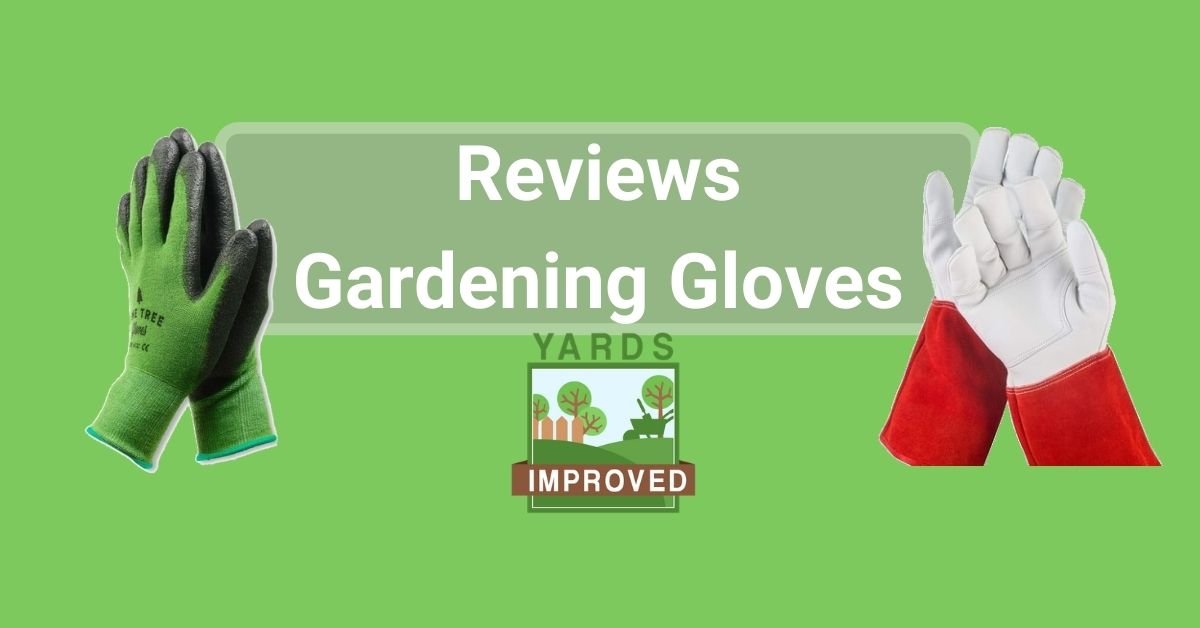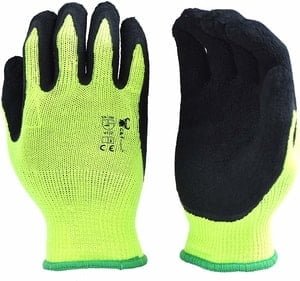Garden is a pleasure for some and a chore for others. But no matter how you feel about it, the routine tasks of weeding, planting, and trimming can take a toll on your hands. It’s not uncommon to deal with scratches, calluses, and dirt under your nails. That’s why a good pair of gardening gloves should be an essential part of your equipment.
Why You Need Quality Gardening Gloves
Our hands have evolved to take a lot of wear and tear. Still, it’s important to protect them. At times, gardening – as simple as it may seem – puts skin and bones at risk.
The thorns, twigs, and rocks we encounter can scratch our skin. Sure, this might not be a big deal most of the time. However, there is the possibility of more serious issues if an infection arises
Gloves also help keep your hands dry and clean. There’s nothing wrong with getting a bit of dirt under the nails, of course. But it’s too easy to spread that dirt when it comes time to clean up. When you lose gloves, you can just toss them off before opening the back door or turning on the faucet.
You’re also likely using fertilizer and insecticides on your plants, and it’s never good to risk getting these near your face. And it’s all too easy to “slip” and forget not to put our hand to our face. Or we might not wash thoroughly enough to get all of the chemicals off. Gloves provide a layer of insulation against this risk.
Well-fitting, quality gloves also protect your hands from calluses and blisters. These can be painful in addition to looking bad. But good gloves provide a cushion against the friction of repeated actions.
Besides the protection for your hands, gloves also offer additional “grip”. They can help you hold your tools more tightly, or wrap your hand more firmly around a weed you want to pull up.
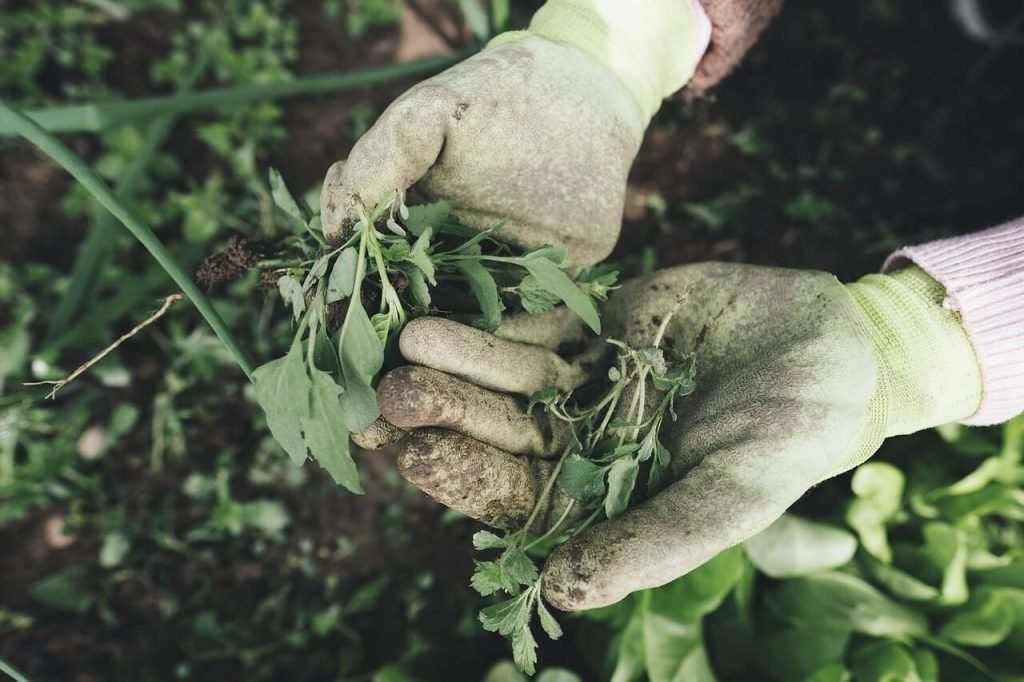
Gardening Glove Styles and Materials
Gardening gloves come in a variety of materials. You’ll also find some helpful options that can make them more useful.
Cloth gloves are fine if you’re just worried about keeping your hands clean. However, there isn’t much resistance in them. They don’t offer a lot of protection except for dirt.
Rubber-coated gloves are ideal for protecting against chemicals. If you’re going to be spraying insecticide, this is a good choice. Some are tough enough for other uses. The drawback is that your hands can get hot and sweaty in these very quickly since they don’t breathe well.
Neoprene gloves are better general-purpose gloves. They won’t stop tough thorns, but they are good for general use. They protect both from scratches and chemicals.
Leather gloves are the best at resisting cuts, scrapes, and other injuries. They generally stand up to almost any physical damage you’ll find in your garden. Good ones are also treated so they can repel common garden chemicals. They are generally more expensive than other types, but it’s a worthwhile investment.
We generally recommend leather gloves for regular use, but if you’re dealing with chemicals a lot, rubber is helpful. That’s not to say that there aren’t individual great pairs of gloves in the other categories, though.
As far as what to look for, you want to be sure to get gloves that are put together well. The sewing should be stable. You shouldn’t have to worry about them coming apart in less than a season.
Comfort is also a key factor. For proper protection, gloves have to fit your hand well. Be sure to try them on, or if ordering online, check the size charts.
An extended wrist protector is also a big help. This comes in hand especially if you often have to reach far in among your plants. The best types include a band that will close the extension tightly around your wrist so that dirt (or bugs) can’t get in.
Check out our guide to the tools you should have in your shed
Caring for Your Gardening Gloves
Of course, it’s important to take care of your gardening gloves if you want them to last. Not all types will last a long time, but you can get the most out of them with a few simple steps.
Take the time to clean your gloves after using them. Water along with mild soap will work on cloth, rubber, or neoprene gloves.
Leather calls for a little extra care – but don’t worry, it’s not hard. We suggest brushing them off first; an old toothbrush or other soft brush will do the trick. Then wash them thoroughly with mild soap and water.
For all types of gloves, it’s important to let them dry properly. Don’t just toss them in a corner! It can help to stick a glove over the handle of a rake or shovel and leave it in a well-ventilated place. Avoid putting them in direct sunlight, though, as they could dry out.
Reviews Of The Best Gardening Gloves
Ready to get your gloves? Let’s look at a few of the best out there.
OLSON DEEPAK Work gloves Leather Gardening Glove
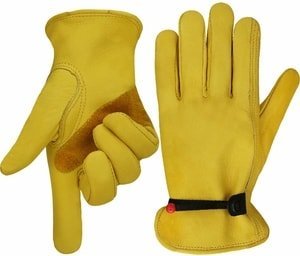
These cowhide leather gloves are both comfortable and offer great protection. They are durable and yet flexible – exactly what you need to be able to work with tools and your hands in the garden.
The wrist protector is not very long, but it does have an elastic strap to prevent dirt from getting inside and irritating your hand. The strap is adjustable.
They are available in medium, large, and extra-large. Most people say the sizes are accurate and that the medium fits an average-sized woman’s hand.
The price is great, too. It’s competitive with gloves of other materials even though the gloves are leather.
Legacy Gardens Leather Gardening Gloves
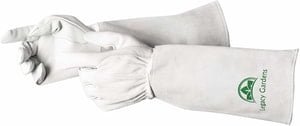
The color is an odd choice, but these gloves from Legacy Gardens have everything you need to get the job done comfortably in your garden.
White garden gloves are a bit unusual, although these were probably designed primarily for rose pruning. They work decently for that but are also suitable for other uses.
While the leather does seem to hold up under general use, it’s not too thick, and sharper thorns may pierce it. Always exercise caution, especially when dealing with plants with true thorns (as opposed to rose prickles).
They are made of goatskin, which is water-resistant as well as supple. This gives it some distinct advantages over other types of leather, including cowhide. Still, it’s not an exotic material, so the price is reasonable.
The wrist guards are long – another element that makes them ideal for pruning roses. However, there’s no way to tighten them.
These gardening gloves are available in sizes from XS to XL.
NoCry Long Leather Gardening Gloves
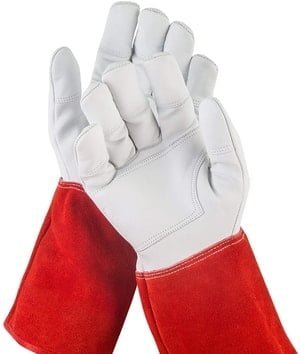
These gloves from NoCry offer protection for your lower arm, the softness of goatskin, and a great overall product. These factors come together to help you work better in your garden.
The company claims they’re even twice as puncture-resistant as other gardening gloves. That’s a bit hard to put to the test since “resistant” is a somewhat vague term. However, they do seem to prevent most scratches from thorns or rose prickles.
Both the fingers and the wristguard have a double layer of leather, which accounts for this durability. But they remain lightweight and breathable, which is great to see and feel.
These are available in only three sizes, providing fewer options than other products we’re looking at here.
A large amount of the complaints with these have to do with handling cactus spines. We don’t recommend them for that, but for general garden use, they are great.
Pine Tree Tools Bamboo Working Gloves
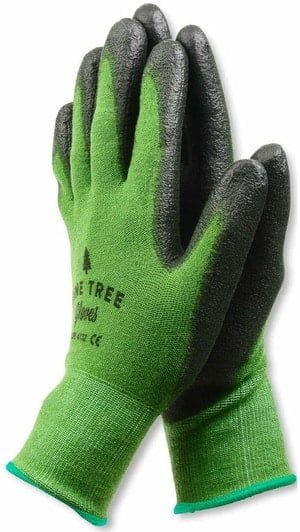
These gloves are totally out of the ordinary, although this could be the way of the future! They’re made of bamboo.
That’s a lot more comfortable than you may be thinking. It’s also breathable. And of course, they hold up well, as bamboo is a tough material. The palms are coated with latex for additional protection. The manufacturer says this isn’t the powdered latex that affects people with allergies. However, we don’t have enough knowledge of the medical side of this to recommend these. We suggest talking to your allergist first.
These are great for general garden use. They are durable and provide basic protection.
Two drawbacks are that they aren’t designed for thorns and that they don’t have an extended wrist/forearm protector.
They aren’t high-end gloves but will work for basic needs. For the price, that’s all you can expect.
They are available in sizes S – XXL.
MicroFoam Textured Latex Waterproof Gardening Gloves – 6 Pack
This pack of 6 pairs of gardening gloves is great for the family, a volunteer group, or to have spares on hand when you wear out one pair. Fortunately, you won’t have to replace them often. They’re durable enough to last a couple of years of regular use
The palm and fingers have a “microfoam” coating to provide extra grip. This is helpful when handling tools or if you need to open the water faucet.
The fit is good and they’re available in sizes S – XL. The price as we write this is great, too.
The gloves are made of a recycled cotton-polyester blend. While we hesitate to say the work as “winter gloves”, they do offer some warmth. At the same time, they breathe well and are comfortable in summer, as well.
4 Pack Showa Atlas Nitrile Garden Gloves
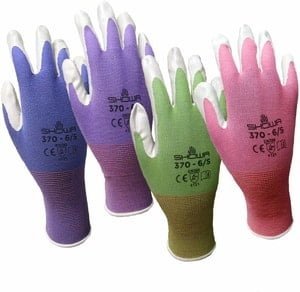
These nitrile gloves are similar to neoprene. The material holds up well and is form-fitting. Your order includes four pairs of gloves. They appear to always come in assorted color pairs, although we can’t say for certain.
Nitrile is water-resistant, so your hands will stay more comfortable when watering or working in damp soil.
They’re comfortable and help keep your hands cool. And, of course, clean.
At press time, these are only available in small.
Conclusion
Keep your hands clean and safe while gardening by using a good set of work gloves. Leather gloves are a great choice, although there are other viable options as well. Be sure to take good care of them, too. They’ll help protect you from scrapes, chemicals, and more!

